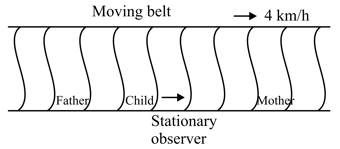wide river flowing at the rate of . A man can swim in still water with He wants to cross the river along the shortest path. Find in which direction should the person swim.

Important Questions on Kinematics
A child runs to and fro with a speed (with respect to the belt) on a long horizontally moving belt (figure) between is father and mother located apart on the moving belt. The belt moves with a speed of . For an observer on the stationary platform outside, what is the speed of the child running in the direction of motion of the belt and speed of the child running opposite to the direction of motion of the belt? time taken by the child in and . Which of the answers will alter if motion is viewed by one of the parents?

Three particles and are situated at point on the circular path of radius All three particles move along different paths and reach point
as shown in the figure. Then the ratio of the distance traversed by particles and is:

